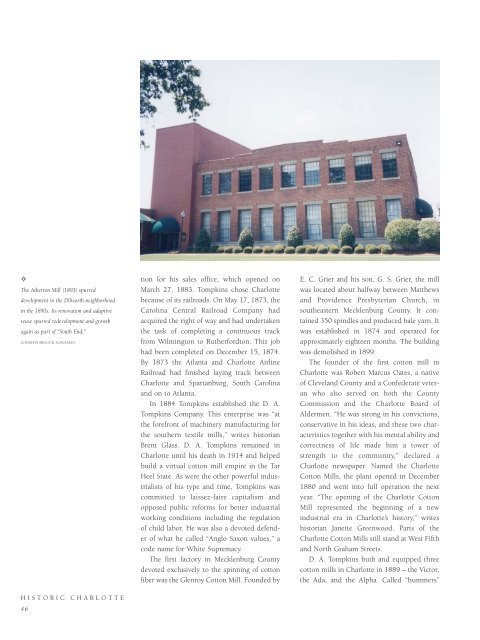Historic Charlotte
An illustrated history of the City of Charlotte and the Mecklenburg County area, paired with the histories of companies, families and organizations that make the region great.
An illustrated history of the City of Charlotte and the Mecklenburg County area, paired with the histories of companies, families and organizations that make the region great.
Create successful ePaper yourself
Turn your PDF publications into a flip-book with our unique Google optimized e-Paper software.
✧<br />
The Atherton Mill (1893) spurred<br />
development in the Dilworth neighborhood<br />
in the 1890s. Its renovation and adaptive<br />
reuse spurred redevelopment and growth<br />
again as part of “South End.”<br />
COURTESY BRUCE R. SCHULMAN.<br />
HISTORIC CHARLOTTE<br />
46<br />
tion for his sales office, which opened on<br />
March 27, 1883. Tompkins chose <strong>Charlotte</strong><br />
because of its railroads. On May 17, 1873, the<br />
Carolina Central Railroad Company had<br />
acquired the right of way and had undertaken<br />
the task of completing a continuous track<br />
from Wilmington to Rutherfordton. This job<br />
had been completed on December 15, 1874.<br />
By 1873 the Atlanta and <strong>Charlotte</strong> Airline<br />
Railroad had finished laying track between<br />
<strong>Charlotte</strong> and Spartanburg, South Carolina<br />
and on to Atlanta.<br />
In 1884 Tompkins established the D. A.<br />
Tompkins Company. This enterprise was “at<br />
the forefront of machinery manufacturing for<br />
the southern textile mills,” writes historian<br />
Brent Glass. D. A. Tompkins remained in<br />
<strong>Charlotte</strong> until his death in 1914 and helped<br />
build a virtual cotton mill empire in the Tar<br />
Heel State. As were the other powerful industrialists<br />
of his type and time, Tompkins was<br />
committed to laissez-faire capitalism and<br />
opposed public reforms for better industrial<br />
working conditions including the regulation<br />
of child labor. He was also a devoted defender<br />
of what he called “Anglo Saxon values,” a<br />
code name for White Supremacy.<br />
The first factory in Mecklenburg County<br />
devoted exclusively to the spinning of cotton<br />
fiber was the Glenroy Cotton Mill. Founded by<br />
E. C. Grier and his son, G. S. Grier, the mill<br />
was located about halfway between Matthews<br />
and Providence Presbyterian Church, in<br />
southeastern Mecklenburg County. It contained<br />
350 spindles and produced bale yarn. It<br />
was established in 1874 and operated for<br />
approximately eighteen months. The building<br />
was demolished in 1899.<br />
The founder of the first cotton mill in<br />
<strong>Charlotte</strong> was Robert Marcus Oates, a native<br />
of Cleveland County and a Confederate veteran<br />
who also served on both the County<br />
Commission and the <strong>Charlotte</strong> Board of<br />
Aldermen. “He was strong in his convictions,<br />
conservative in his ideas, and these two characteristics<br />
together with his mental ability and<br />
correctness of life made him a tower of<br />
strength to the community,” declared a<br />
<strong>Charlotte</strong> newspaper. Named the <strong>Charlotte</strong><br />
Cotton Mills, the plant opened in December<br />
1880 and went into full operation the next<br />
year. “The opening of the <strong>Charlotte</strong> Cotton<br />
Mill represented the beginning of a new<br />
industrial era in <strong>Charlotte</strong>’s history,” writes<br />
historian Janette Greenwood. Parts of the<br />
<strong>Charlotte</strong> Cotton Mills still stand at West Fifth<br />
and North Graham Streets.<br />
D. A. Tompkins built and equipped three<br />
cotton mills in <strong>Charlotte</strong> in 1889 – the Victor,<br />
the Ada, and the Alpha. Called “hummers”
















